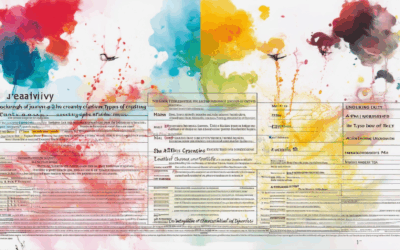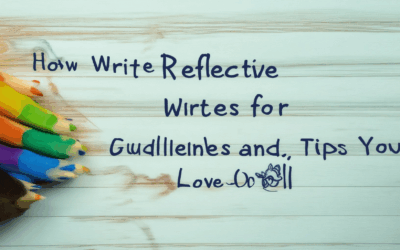Exploring the intricate world of literary reflection and essays offers a transformative journey into the depths of analysis and self-discovery. For anyone seeking to refine their writing skills or delve deeper into textual interpretation, understanding the nuances of literary reflection and essays is essential. This article delves into the complexities of these written forms, providing clear examples, structural guidance, and practical tips to help you master the craft. From distinguishing between essays and reflections to unraveling the components of a reflective essay, this comprehensive exploration will equip you with the tools needed to excel in both academic and creative endeavors. Whether you’re a seasoned writer or just beginning, this guide promises insights that will enhance your analytical abilities and empower you to craft compelling literary works.
Key Takeaways
– What is a Reflective Essay? A reflective essay is a personal, introspective piece that explores themes through the writer’s unique perspective, often blending personal experiences with broader ideas.
– Characteristics of Reflective Essays Include a strong personal focus, subjective tone, use of figurative language, and reliance on personal insights rather than external research.
– Purpose of Reflective Essays They aim to facilitate self-reflection, explore personal growth, and connect individual experiences to larger themes or societal issues.
– Common Themes in Reflective Essays Topics often include coming-of-age experiences, relationships, career decisions, cultural identity, and social issues.
– Publishing Reflective Essays Platforms like Silken Drum provide spaces for sharing reflective writing and connecting with like-minded readers.
– Types of Reflective Essays Two main forms exist: experiential, focusing on personal experiences, and textual, analyzing literature or texts.
– Structure of Reflective Essays Typically follow a three-part format: introduction, body, and conclusion, guiding readers through the writer’s journey of self-discovery.

Understanding the Difference Between an Essay and a Reflection
An essay and a reflection are both forms of writing, but they serve different purposes and have distinct structures. Here’s a breakdown of their key differences:
- Structure:
- Essay: Typically follows a structured format with an introduction, body, and conclusion. It often includes a thesis statement and supporting evidence.
- Reflection: Lacks a fixed structure. It is often personal and introspective, focusing on feelings and experiences rather than external evidence.
- Purpose:
- Essay: To communicate ideas, present arguments, or convey information in a clear and organized manner.
- Reflection: To explore personal thoughts, emotions, or experiences in a meaningful way.
- Audience:
- Essay: Intended for a broader audience, such as teachers, readers, or researchers.
- Reflection: Often written for oneself, though it can be shared with others to evoke understanding or empathy.
- Flexibility:
- Essay: Requires adherence to specific guidelines, such as grammar, spelling, and structure.
- Reflection: More flexible and personal, allowing for a range of emotional expression and exploration.
In summary, an essay is a structured, formal piece of writing aimed at informing or persuading, while a reflection is a personal and introspective exploration of thoughts and feelings. Both have their place in writing, but they fulfill different needs and purposes.
What is a Literary Reflection?
A literary reflection is a critical analysis of literary works, focusing on interpreting themes, motifs, and symbolic elements to gain deeper insights into the author’s intent and the broader cultural or philosophical meanings embedded in the text. Unlike mere summaries, literary reflections delve into the intrinsic qualities of literature, often inviting readers to explore personal connections or universal truths.
Definition and Purpose
- Literary reflection serves as a tool for readers to engage more deeply with texts, fostering a richer understanding of their meaning and significance.
- It encourages readers to connect individual readings with broader literary traditions, historical contexts, and societal issues.
Importance of Literary Reflection
- Enhances comprehension by prompting close reading and analysis of textual details.
- Facilitates critical thinking by challenging readers to evaluate interpretations and draw conclusions.
- Bridges the gap between personal interpretation and scholarly analysis, making literature accessible to a wider audience.
Techniques for Literary Reflection
- Analyzing symbolism and imagery to uncover hidden meanings.
- Exploring character development and motivation to understand psychological dimensions.
- Investigating narrative structure and stylistic choices to reveal storytelling techniques.
- Connecting literary works to historical, political, or cultural contexts to situate them within a larger framework.
Examples in Practice
- In To Kill a Mockingbird , Atticus Finch’s reflections on justice and morality inspire readers to reconsider societal norms.
- The recurring motif of light and darkness in Pride and Prejudice reflects the internal and external conflicts faced by its characters.
- Analyzing The Great Gatsby ‘s use of illusion versus reality reveals the complexities of identity and materialism in the Jazz Age.
Engaging with Literary Reflection
- Readers can begin by identifying key elements of a text that stand out to them personally.
- Asking questions like “What does this symbol mean to me?” or “How does this theme relate to my life?” can deepen the reflection process.
- Sharing reflections with others in book clubs or online forums encourages diverse perspectives and enriches the discussion.
By embracing literary reflection, readers not only enhance their own literacy skills but also cultivate a lifelong appreciation for the power of words and stories.

What are the 5 R’s of reflection?
The 5R framework for reflection is a powerful tool for personal growth and self-awareness. It consists of five interconnected components that guide individuals through the process of reflecting on their experiences, emotions, and actions. Here’s a breakdown of each component:
- Reporting
- This involves documenting your thoughts, feelings, and observations. It’s about capturing the essence of your experience in a tangible way, whether through journaling, recording audio, or simply noting key moments. Effective reporting helps you retain details that might otherwise fade away.
- Responding
- After reporting, you move into responding to your own narrative. This means exploring your emotions and reactions to what has happened. It’s about questioning assumptions, acknowledging biases, and understanding the deeper meanings behind your experiences. Responding helps you connect with your authentic self.
- Relating
- Relating involves connecting your personal experience to broader contexts. This could mean drawing parallels with past events, cultural narratives, or universal themes. By relating, you gain perspective and often uncover patterns or lessons that resonate beyond your individual story.
- Reasoning
- Reasoning is about analyzing your thoughts and actions critically. It involves questioning cause and effect, considering alternative viewpoints, and seeking evidence to support your conclusions. This step enhances your ability to make informed decisions and fosters critical thinking skills.
- Reconstructing
- Finally, reconstructing allows you to synthesize your reflections into a coherent whole. This might involve creating a summary, identifying takeaways, or developing an action plan based on your insights. Reconstruction ensures that your reflection leads to meaningful growth and future application.
By systematically applying these five Rs—Reporting, Responding, Relating, Reasoning, and Reconstructing—you can develop a rich, introspective practice that enriches your life and enhances your personal development.

What is a Reflective Essay in Literature?
A reflective essay is a type of personal essay that focuses on examining a topic through the lens of your unique perspective. Unlike traditional academic essays, reflective essays are more introspective and often prioritize personal experiences, emotions, and observations over factual information. These essays are characterized by their ability to connect the writer’s individual journey with broader themes or ideas.
Key Characteristics of Reflective Essays
- Personal Focus : Reflective essays are deeply personal, allowing the writer to share their thoughts, feelings, and experiences.
- Subjectivity : The tone is often subjective, as the writer reflects on their own beliefs, values, and reactions to a topic.
- Figurative Language : Use of metaphors, similes, and other figurative language helps bring the essay to life and convey complex emotions.
- No Academic Sources Required : While reflective essays can draw inspiration from various sources, they don’t typically rely on external research or citations.
Purpose of Reflective Essays
Reflective essays are often written to explore personal growth, examine a particular experience, or reflect on a significant event. They can also serve as a tool for self-reflection, helping writers understand their thoughts and feelings more deeply.
Examples of Themes
- Coming-of-age experiences
- Relationships and their impact on the writer
- Career decisions or professional growth
- Cultural identity and heritage
- Social issues and personal connections
Where to Publish Reflective Essays
If you’re looking to showcase your reflective writing, platforms like Silken Drum provide a supportive space for writers to share their work. This platform encourages creativity and offers opportunities to engage with like-minded individuals who appreciate the power of the written word.
By combining personal storytelling with introspective analysis, reflective essays offer a unique way to explore and express complex emotions while fostering deeper understanding of oneself and the world around.
What are the two main types of reflective essays?
Reflective essays are a common assignment in various educational settings and are often used to encourage critical thinking and self-reflection. There are primarily two main types of reflective essays:
1. Experiential Reflective Essays
These essays focus on personal experiences, observations, or interactions. The writer reflects on their own feelings, actions, or experiences in a particular situation. Examples include:
Experiential reflective essays often involve:
2. Textual Reflective Essays
Textual reflective essays analyze and interpret texts, such as books, articles, or speeches. The writer examines themes, symbols, or arguments presented in the text and reflects on their significance. Examples include:
Textual reflective essays often involve:
Both types of reflective essays require careful analysis, introspection, and the ability to connect personal insights with broader ideas. Whether focusing on personal experiences or textual analysis, the goal is to foster deeper understanding and self-awareness.
For more tips on improving your reflective writing skills, visit Silken Drum .

What Are the Three Parts of a Reflective Essay?
A reflective essay typically follows a structured format to allow for deep introspection and personal growth. Here are the three primary components:
- Introduction
- The introduction sets the stage for the essay by introducing the writer and the subject matter. It often begins with a personal anecdote, a significant life event, or a statement of intent that highlights the focus of the reflection.
- Body
- The body is the most extensive part of the essay, where the writer explores their thoughts, feelings, and experiences. This section may be subdivided into smaller paragraphs or themes, each addressing a specific aspect of the reflection. Common structures include:
- Discussing a particular experience or interaction.
- Analyzing emotions or reactions to a situation.
- Examining broader societal or cultural influences.
- Reflecting on personal growth or learning.
- Conclusion
- The conclusion ties the essay together by summarizing the key insights gained from the reflection. It often includes a synthesis of emotions, lessons learned, or changes in perspective. The writer may also discuss how these insights impact their future actions or beliefs.
By organizing their thoughts around these three parts, writers can effectively communicate their journey of self-discovery and foster meaningful connections with their audience.




0 Comments